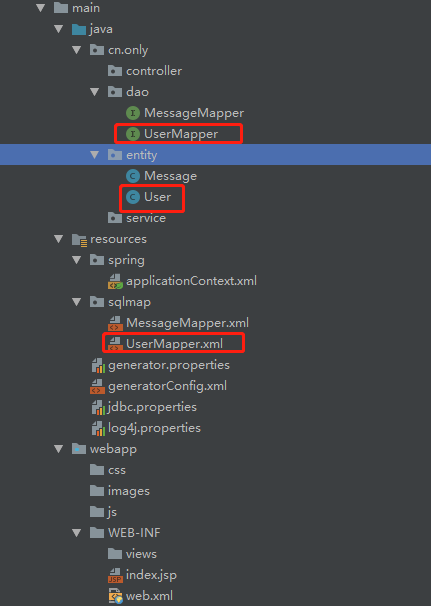上面两篇博客已经详细的介绍了在IntelliJ IDEA 搭建SSM框架的整个过程,下面我们就要在搭建好的环境里实现我们想要的功能了。本文完成用户的登录功能,主要包括:用户注册,登录,编辑,退出,注销。
第一步:设计user表,并用mybatis-geneator生成user表对应的数据文件
首先,我们在test数据库里加一张user表,代码如下
use test; CREATE TABLE `user` ( `id` int(10) unsigned NOT NULL AUTO_INCREMENT, `name` varchar(40) NOT NULL, `password` varchar(255) NOT NULL, `age` int(4) NOT NULL, `description` varchar(255) NOT NULL, PRIMARY KEY (`id`) )ENGINE=InnoDB AUTO_INCREMENT=1 DEFAULT CHARSET=utf8; select * from user;
然后,用mybatis-geneator生成user表对应的数据文件。打开generator.properties文件,table=message改为table=user,点击IntelliJ IDEA右侧边栏的Maven Projects,双击 mybatis-generator:generate,运行成功以后会多user表的相关数据文件,如下图:

注意:如果需要一次生成所有表的数据文件,先把dao,entity,sqlmap里面的文件都清空,然后打开generatorConfig.xml,把table标签替换为下面的代码即可
<table schema="" tableName="%" enableCountByExample="false"
enableUpdateByExample="false" enableDeleteByExample="false"
enableSelectByExample="false" selectByExampleQueryId="false"/>
现在,user数据表已经绑定成功。下面按照上一篇中测试message的方法,用junit测试工具,测一下数据能不能正常写入数据库。
第二步:新建文件
在controller文件夹下添加userController.java和homeController.java文件
userController.java:跟用户有关的路由都会写在这个文件里
homeController.java:写登录成功以后的路由
在service文件夹下,添加UserService.java文件和impl文件夹,在impl文件夹下,添加UserServiceImpl.javaUserService.java:存放业务层接口
UserServiceImpl.java:实现业务层接口
在js文件夹下添加jQuery文件引用,我这里加的是jquery-3.3.1.js
在views文件夹下添加:login.jsp,home.jsp,detail.jsp,register.jsp
login.jsp:登录页面
home.jsp:登录以后的页面
detail.jsp:编辑用户信息页面
register.jsp:用户注册页面
第三步:首页
index.jsp代码如下:

<%@ page contentType="text/html;charset=UTF-8" language="java" %> <html> <head> <meta http-equiv="Content-Type" content="text/html; charset=UTF-8"> </head> <body> <h2>欢迎来到首页,请先登录</h2> <div> <a href="/user/login">登录</a> <a href="/user/register">注册</a> </div> </body> </html>
第四步:注册功能
1,写注册页面,在register.jsp中添加代码如下:

<%@ page contentType="text/html;charset=UTF-8" language="java" %> <html> <head> <title>Title</title> </head> <body> <h2>用户注册</h2> <form action="/user/register" method="post"> 用户名:<input type="text" name="name"> 密码:<input type="password" name="password"> 年龄:<input type="text" name="age"> 描述:<input type="text" name="description"> <input type="submit" value="保存"> </form> </body> <script> if(${status} == 0){ alert("注册成功") location.href="/"; } </script> </html>
2,dao中实现数据库操作
dao文件夹中的UserMapper已经有insert接口,sqlmap中的UserMapper.xml中已经实现insert,所以只需在
dao文件夹中的UserMapper中添加selectUserByName接口,在sqlmap中的UserMapper.xml中添加selectUserByName实现。代码如下:
List<User> selectUserByName(User record);
<select id="selectUserByName" resultMap="BaseResultMap" parameterType="cn.only.entity.User" > select * from user where name = #{name,jdbcType=VARCHAR} </select>
3,service层实现业务逻辑
在UserService.java中写注册接口insert,和根据用户名查找用户接口selectUserByName,代码如下:

package cn.only.service; import cn.only.entity.User; import java.util.List; public interface UserService { int insert(User record); List<User> selectUserByName(User record); }
4,在UserServiceImpl.java中实现以上接口,代码如下:

package cn.only.service.impl; import cn.only.dao.UserMapper; import cn.only.entity.User; import cn.only.service.UserService; import org.springframework.beans.factory.annotation.Autowired; import org.springframework.stereotype.Service; import java.util.List; @Service public class UserServiceImpl implements UserService{ @Autowired private UserMapper mapper; public int insert(User record){return mapper.insert(record);} public List<User> selectUserByName(User record){return mapper.selectUserByName(record);} }
5,在userController.java中写路由,代码如下:

package cn.only.controller; import cn.only.entity.User; import cn.only.service.UserService; import org.springframework.stereotype.Controller; import org.springframework.ui.Model; import org.springframework.web.bind.annotation.ModelAttribute; import org.springframework.web.bind.annotation.RequestMapping; import org.springframework.web.bind.annotation.RequestMethod; import org.springframework.web.bind.annotation.ResponseBody; import javax.annotation.Resource; import javax.servlet.http.HttpServletRequest; import javax.servlet.http.HttpSession; import java.util.List; @Controller @RequestMapping("/user") public class userController { @Resource private UserService userService; @RequestMapping(value="/register") public String register(HttpServletRequest request, Model model){ return "register"; } @RequestMapping(value="/register",method= RequestMethod.POST) public String addUser(@ModelAttribute User user, Model model){ List<User> list=userService.selectUserByName(user); if(list.size()==0){ if(userService.insert(user)==1){ model.addAttribute("status",0); }else{ model.addAttribute("status",1); } }else{ model.addAttribute("status",2); } return "register"; } }
第五步:登录功能
1,写登录页面,在login.jsp文件,代码如下:

<%@ page contentType="text/html;charset=UTF-8" language="java" %> <html> <head> <title>登录</title> </head> <h2>登录</h2> <form action="/user/login" method="post"> 用户名:<input type="text" name="name"> 密码:<input type="password" name="password"> <input type="submit" value="登录"> <a href="/user/register">注册</a> </form> </body> <script> if(${status} == 0){ alert("登录成功"); location.href="/home"; }else{ alert("登录失败,用户名或密码错误"); } </script> </html>
2,dao中实现数据库操作
dao文件夹中的UserMapper中添加login接口,在sqlmap中的UserMapper.xml中添加login实现。代码如下:
User login(User record);
<select id="login" resultMap="BaseResultMap" parameterType="cn.only.entity.User" > select * from user where name = #{name,jdbcType=VARCHAR} AND password=#{password,jdbcType=VARCHAR} </select>
3,service层实现业务逻辑
在UserService.java中写登录接口login,代码如下:
User login(User record);
4,在UserServiceImpl.java中实现以上接口,代码如下:
public User login(User record){return mapper.login(record);}
5,在userController.java中写路由,添加代码如下:

@RequestMapping(value="/login") public String loginPage(@ModelAttribute User user, Model model){ return "login"; } @RequestMapping(value="/login",method= RequestMethod.POST) public String login(@ModelAttribute User user, Model model, HttpSession session){ User u=userService.login(user); if(u!=null){ u.setPassword(""); session.setAttribute("user", u); model.addAttribute("status",0); model.addAttribute("user",user); }else{ model.addAttribute("status",1); } return "login"; }
第六步:登录成功以后的页面home
home.jsp代码如下:

<%@ page contentType="text/html;charset=UTF-8" language="java" isELIgnored="false" %> <html> <head> <title>主页</title> <script src="/js/jquery-3.3.1.js"></script> </head> <body> <script> function deleteUser() { if(confirm("用户一旦删除需要重新注册,确定删除用户?")){ jQuery.ajax({url:"/user/delete",async:false,type:"DELETE", success:function (restult) { if(restult == 1){ alert("用户注销成功"); location.href="/user/login"; }else{ alert("用户注销失败"); } } }); } } </script> <p style="margin-top:100px;text-align: center">欢迎<span style="font-weight: bolder">${user.name}</span>登录</p> <a href="/user/detail">修改个人信息</a> <a href="/user/logout">退出</a> <a href="JavaScript:void(0)" onclick="deleteUser()">注销</a> </body> <script> </script> </html>
在homeController.java中写路由,添加代码如下:

package cn.only.controller; import cn.only.entity.User; import cn.only.service.UserService; import org.springframework.stereotype.Controller; import org.springframework.ui.Model; import org.springframework.web.bind.annotation.RequestMapping; import javax.annotation.Resource; import javax.servlet.http.HttpSession; @Controller public class homeController { @Resource private UserService userService; @RequestMapping(value="/home") public String home(HttpSession session, Model model){ User u = (User) session.getAttribute("user"); if(u != null){ model.addAttribute("user", u); } return "home"; } }
第七步:编辑用户
1,编辑页面,在detail.jsp文件,代码如下:

<%@ page contentType="text/html;charset=UTF-8" language="java" %> <html> <head> <title>用户信息</title> </head> <h2>用户信息修改</h2> <form action="/user/detail" method="post"> 用户名:<input type="text" name="name" value="${user.name}" disabled> 年龄:<input type="text" name="age" value="${user.age}"> 描述:<input type="text" name="description" value="${user.description}"> <input type="submit" value="保存"> </form> </body> <script> if(${status} == 0){ alert("修改成功") location.href="/home"; } </script> </html>
2,dao中实现数据库操作
dao文件夹中的UserMapper中默认已经添加了selectByPrimaryKey和updateByPrimaryKey两个接口
在sqlmap中的UserMapper.xml中也已经实现上面的接口。updateByPrimaryKey修改代码如下:
<update id="updateByPrimaryKey" parameterType="cn.only.entity.User" >
update user
set name = #{name,jdbcType=VARCHAR},
age = #{age,jdbcType=INTEGER},
description = #{description,jdbcType=VARCHAR}
where id = #{id,jdbcType=INTEGER}
</update>
3,service层实现业务逻辑
在UserService.java中添加根据id查找用户接口selectByPrimaryKey和更新用户接口updateByPrimaryKey,代码如下:
User selectByPrimaryKey(Integer id);
int updateByPrimaryKey(User record);
4,在UserServiceImpl.java中实现以上接口,代码如下:
public User selectByPrimaryKey(Integer id){return mapper.selectByPrimaryKey(id);}
public int updateByPrimaryKey(User record){return mapper.updateByPrimaryKey(record);}
5,在userController.java中写路由,添加代码如下:

@RequestMapping(value="/detail") public String detail(HttpSession session, Model model){ int id=((User)session.getAttribute("user")).getId(); User u =userService.selectByPrimaryKey(id); model.addAttribute("user",u); return "detail"; } @RequestMapping(value="/detail",method= RequestMethod.POST) public String editUser(@ModelAttribute User user, Model model,HttpSession session){ User un = (User) session.getAttribute("user"); User u=(User)userService.selectByPrimaryKey(un.getId()); if(u!=null){ user.setId(un.getId()); user.setName(un.getName()); if(userService.updateByPrimaryKey(user)==1){ model.addAttribute("status",0); }else{ model.addAttribute("status",1); } }else{ model.addAttribute("status",2); } return "detail"; }
第八步:退出
在userController.java中写退出路由,添加代码如下:
@RequestMapping(value="/logout",method= RequestMethod.GET) public String logout(HttpSession session){ session.invalidate(); return "redirect:/user/login"; }
第九步:注销
注销用户:删除用户
home.jsp中发送的ajax请求如下
function deleteUser() { if(confirm("用户一旦删除需要重新注册,确定删除用户?")){ jQuery.ajax({url:"/user/delete",async:false,type:"DELETE", success:function (restult) { if(restult == 1){ alert("用户注销成功"); location.href="/user/login"; }else{ alert("用户注销失败"); } } }); } }
dao文件夹中的UserMapper中默认已经添加了deleteByPrimaryKey接口
在sqlmap中的UserMapper.xml中的实现代码如下:
<delete id="deleteByPrimaryKey" parameterType="java.lang.Integer" > delete from user where id = #{id,jdbcType=INTEGER} </delete>
在userController.java中写路由,添加代码如下:
@ResponseBody @RequestMapping(value="/delete",method= RequestMethod.DELETE) public Integer delete(HttpSession session, Model model){ User u = (User) session.getAttribute("user"); int result=0; if(u != null){ result= userService.deleteByPrimaryKey(u.getId()); session.setAttribute("user",null); System.out.println("Result:"+result); } return result; }
到此已经完:用户注册,登录,编辑,退出,注销。
代码下载地址:https://github.com/greenteaone/helloworld
